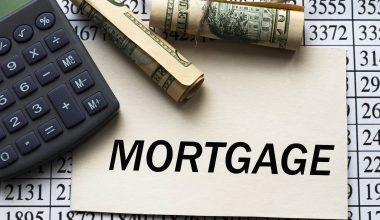Some individuals want to buy an expensive house, but they do not have enough money for it. A jumbo loan is an option for purchasing a mortgage. This article talks about the jumbo mortgage limit for 2023, the best rates, and jumbo vs. conventional loans. Before we get into details, let’s shed a little light on the word “Jumbo” and “Mortgage.”
The word jumbo means very big, very large of something, while the word mortgage means a loan or property owned by an individual to be used as collateral in settling the lender’s (bank) debt.
What Is the Jumbo Mortgage Limit?
The jumbo mortgage limit is the loan limit that comes in if a loan exceeds the loan rules set by Fannie Mae and Freddie Mac, which is about $726,200 for a single-family home in all states except some federally designed high-cost places, where the limit is $1,089,300.
It has a high-interest rate, strict rules, and a larger down payment than a standard mortgage. They are available for investment properties, second homes, etc.
The jumbo mortgage, or jumbo loan, does not follow the rules set by Fannie Mae and Freddie Mac, whose limits are designed for highly competitive houses. Jumbo mortgages also come with underwriting requirements and tax implications, unlike traditional mortgages and even conventional loans in the county. The jumbo mortgage limits vary by state.
If you want your loan to be a conforming loan, your credit score, debt-to-income ratio, loan-to-value ratio (LTV), and income records must meet Fannie Mae and Freddie Mac’s rules set. Loan limits are also considered to know if it will be a conforming loan.
How Do I Qualify for a Jumbo Mortgage Loan?
People who qualify for a jumbo mortgage have to prove their means of paying off the loan debt. The requirements of the loan debt vary by the investor; the investors are at potential risk. But the major requirements you expect to see include:
#1. Credit Score
As a borrower, you’ll need to have a credit score of 700 or above, as one of the requirements, or prove to the investor, that you want to qualify for the loan.
#2. Debt-To-Income Ratio
Investors look for a (DTI) ratio of around 40% to see how much the borrower owes and how much the borrower makes.
#3. Cash Reserves
The investors also seek to know if you have a savings reserve that will be enough for 6 to 12 months of paying your debts and interest. They check if you have enough money in the bank to see if you will qualify for the loan.
#4. Loan-To-Value Ratio
Investors check your LTV ratio by dividing your loan by the total purchase price of the property with a low outcome.
#5. Put Down Payment
To qualify for a jumbo loan, you, as a borrower, have to put down a payment. The more you can put down, the better because it helps lower your LTV ratio and shows you that you have the means of paying for the loan.
What Are the Benefits of a Jumbo Mortgage?
As expensive and risky as a jumbo mortgage may be, it still has its own benefits. They are;
- Borrowers have the opportunity to buy expensive homes.
- Jumbo loans favor investors through their jumbo rates and have many options for investors’ companies.
- Jumbo has its own low-interest rate depending on the market level.
The Disadvantages of a Jumbo Loan
Here are the cons of jumbo loans. They are;
- Any interest rate that is low will make the borrower pay more money when paying off the debt.
- Jumbo loans are too risky for both investors and borrowers.
- It is because of the jumbo loan requirements that it is difficult for borrowers to prove some documents, like a high credit score.
How Do I Obtain a Jumbo Mortgage Loan?
To obtain a jumbo loan,
- You must have a rigorous credit requirement because it carries more credit risk for the lender because there is no guarantee by Fannie Mae or Freddie Mac. You need a stellar credit score of 700 or above and a very low debt-to-income (DTI) ratio, which should be 43% or 36%.
- You show proof that you have accessible cash on hand to cover your payments. You need liquid assets to qualify, proper documentation on other loans held, and proof of non-liquid assets. Meet professional guidelines.
Jumbo Mortgage Limit 2023
The federal housing finance agency (FHFA) sets a loan limit on an annual basis. The jumbo mortgage limit for a single-family apartment in 2023 is $726,200. For most countries with higher home values, the limit is $1,089,300, or 150% of $726,200. The rules are to cover both the United States and some countries outside the United States for loan limit calculations.
The limit for jumbo mortgage loan rates for 2023 in Alaska, Hawaii, Guam, and the U.S. Virgin Islands is $1,089,300 and can have the best or higher rates in some countries with higher home values. The best rate is 20%
Best Jumbo Mortgage Rates
Mortgage rates are the number of interest borrowers are charged by the lender in exchange for lending. Rates can be fixed or adjusted, and fixed rates can’t change till the mortgage loan is over. While the adjustable rate can be changed based on the mortgage term, it can be six months or a year.
Although jumbo mortgages have higher interest rates, the average percentage for a jumbo mortgage annually is often on par with the conventional mortgage. Create a profile with a credit score ranging from 700 to 760 with a property loan to a value ratio of 80% and representative of real consumers to see when to find a mortgage and your front end of your (DTI) must be 28% of your total income. Borrowers may ask for 10% down to avoid expenses and get a better rate. It is good to aim at 20% jumbo mortgage rates.
Jumbo Reverse Mortgage Limits in 2023:
The exact limit for a jumbo reverse mortgage varies depending on the lender, but it can typically be as high as $4 million or more.
Jumbo reverse mortgages are typically more expensive than standard reverse mortgages because they come with higher interest rates and closing costs. Additionally, they are less common than standard reverse mortgages and may be harder to find. However, they can be a useful option for homeowners who have a high-value home and want to borrow a larger amount than the standard loan limit.
It’s important to note that these limits may change over time, as they are determined by the
government and they are subject to change based on the market condition.
Is 2023 the Best Year to Buy a House?
The rise in property prices can be attributed to the high demand from buyers. Because there are fewer people selling homes, the prices of homes are going up, which means prospective buyers will have to pay more. As a consequence of this, the cost of a house will most likely be more expensive in 2023. In addition, in contrast to 2021, it is possible that you will not be able to obtain a low-interest rate on your mortgage.
Can You Put a 10% On a Jumbo Loan?
When applying for a jumbo loan, you should anticipate having to make a down payment that is at least 10% of the total loan amount. A minimum down payment of 25%, and in some cases even 30%, may be required by certain lenders. Although a down payment of 20% of the purchase price is considered to be a good benchmark, it is always best to speak with your lender about all of your options.
What Will Happen to Mortgage Rates in 2024?
According to the projections made by Capital Economics, the average rate on a five-year fix will be 4.48 percent in December 2023. This will place it marginally below the Bank Rate, which is currently set at 4.5 percent. The Bank Rate will go down to 4.25 percent the following month, which will be followed by another decrease in mortgage rates to 4.37 percent in January 2024.
Is It Harder to Get a Jumbo Mortgage?
Large loans that exceed the limits set by the federal government are known as jumbo mortgages. The requirements to qualify for these loans are typically more stringent than the requirements for conforming loans; however, the interest rates they offer may be more competitive. Borrowers have an easier time securing the funds they need to make expensive real estate purchases thanks to the convenience of these loans.
Jumbo vs. Conventional Loans
Jumbo loans are for financing highly-priced properties of at least $500,000 or more (millions). They are non-conforming, they are not part of the (FHFA) and Fannie Mae or Freddie Mac rules. $647,200 for a single-family home in most of the United States has a higher amount than that.
Conventional loans sometimes do not follow the (FHFA) if they are non-conforming loans, which means the conforming loans are subject to the size limits set by Fannie Mae, Freddie Mac, or the (FHFA) for the size of the loan. For a conventional loan, the price limit is $762,200.
Here are the differences between jumbo vs. conventional loans: They are;
- In jumbo vs conventional loans, jumbo loans are always higher or more expensive to get than conventional conforming loans.
- Obtaining a Jumbo loan is harder to qualify for than a conventional loan.
- In jumbo vs conventional loans, When paying off the loan of a jumbo loan, it is always higher than the conventional loan because of its interest rate.
Why Do Jumbo Loans Not Have PMI?
Due to the higher down payment that is typically required for jumbo loans, the majority of the time you will not be required to pay for private mortgage insurance (PMI). Homebuyers who put down less than 20 percent are the target audience for private mortgage insurance (PMI). However, because the minimum amount of the down payment that each lender requires will be different, it is possible that your lender will require private mortgage insurance (PMI) in exchange for a lower down payment.
What Credit Score Do You Need for a 500K Mortgage?
When applying for a conventional loan, it is recommended that you have a credit score of 620 or higher on your credit report. If your credit score is below 620, lenders will either not be able to approve your loan or will be required to offer you a higher interest rate, which can result in higher monthly payments. If your score is above 720, lenders will either be able to approve your loan or will offer you a lower interest rate.
Is It Worth Putting Large Down Payment?
A higher down payment may result in a reduction in other monthly costs, such as private mortgage insurance premiums, in addition to the obvious benefit of a lower loan amount (PMI). With a down payment of at least 20%, private mortgage insurance (PMI) can be waived by the lender because the lender believes it is less likely that the borrower will default on their mortgage. You will use up a greater portion of the cash reserves you have available.
What Steps Do I Take To Get a Jumbo Loan?
You have to use these procedures to get a jumbo mortgage loan, and they are as follows:
#1. You Have to Identify if You Need a Jumbo Mortgage
To identify whether you need a jumbo mortgage, you have to know that jumbo mortgages are luxury and expensive. That is, if you buy a cheaper apartment for $400,000, it is not a jumbo mortgage. Jumbo mortgages are expensive; they range from $500,000 to millions of millions depending on their prices, and they change yearly. They are not conforming to loans from the federal government or rules set by Freddie Mac and Fannie Mae. The jumbo mortgage prices are set by private investors, banks, etc.
#2. Find Lenders for Jumbo Mortgages for Their Guidelines
You have the lender for the jumbo mortgage, and you ask for their minimum credit score, how many months of reserves you need, what the down payment requirement is (the best is 20%), and lastly, your debt-to-income ratio.
#3. Negotiate With Them
By buying a mortgage loan, you have to talk to the lender. If you are single, married, or divorced and have any problems that will hinder you from paying your jumbo mortgage, tell the investor.
#4. Get Pre-approval
When getting a jumbo loan, get pre-approval from two different investors because their guidelines differ. If anything changes in your life, let the two investors know, like; you have a change of job, etc.
Conclusion
If you want to borrow more than a conforming loan, you will have to get a jumbo loan. In a jumbo mortgage, the lower the interest rates, the higher the amount when settling the debt. It is hard to qualify for a jumbo loan, and it is risky. You can also seek the help of professionals.
Jumbo Mortgage Limits FAQs
Is a jumbo loan risky?
Jumbo loans are risky by the day and even more risky as the time comes for lenders. It has different underwriting guidelines than traditional mortgages. It is because the jumbo loans are not set up by Fannie Mae and Freddie Mac. Investors gain more when the dollar value of the loan is higher, and the investor gains an opportunity to sell additional services to the borrowers.
Should I put 20% down on a jumbo loan?
Yes, some investors will want you to put down a more substantial down payment, like 25% or 30%. But the lowest is 10%, and the lower the interest rate when paying the debt, you will likely pay a huge amount. So the best rate is 20%. Negotiate with your investor for more options and to solve your problem when getting a jumbo loan.
What credit score is needed for a jumbo loan?
When getting a jumbo loan, your investor will want to see your credit score. Your minimum is 700, but for conforming loans, the minimum is 620
- WHAT IS A JUMBO MORTGAGE? Rates and Limits In 2023
- REVERSE MORTGAGE COMPANIES: Top 10 Lenders In 2023
- Best Jigsaw Puzzle Brands: 29+ Popular Brands In The World
- FORECLOSURE LISTINGS: How to Find Free Foreclosure listings stress-free
- Best Lingerie Brands: 50 Best Lingerie Brands in 2023
- INSTALLMENT LOAN: Best Installment Loans in 2023






